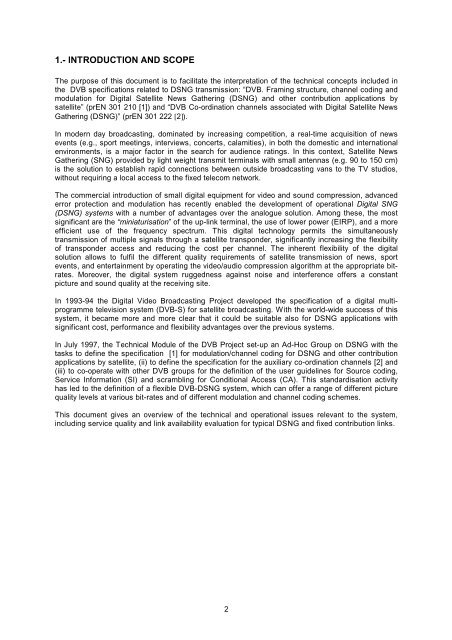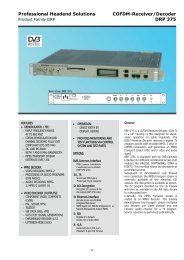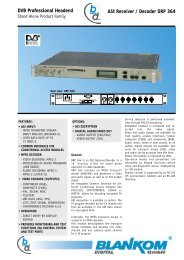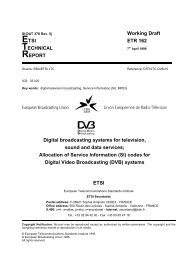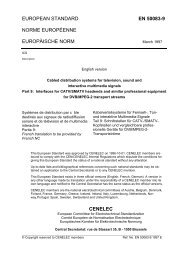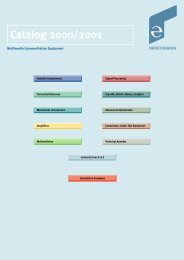Digital Video Broadcasting (DVB); User guidelines for Digital ...
Digital Video Broadcasting (DVB); User guidelines for Digital ...
Digital Video Broadcasting (DVB); User guidelines for Digital ...
You also want an ePaper? Increase the reach of your titles
YUMPU automatically turns print PDFs into web optimized ePapers that Google loves.
1.- INTRODUCTION AND SCOPE<br />
The purpose of this document is to facilitate the interpretation of the technical concepts included in<br />
the <strong>DVB</strong> specifications related to DSNG transmission: “<strong>DVB</strong>. Framing structure, channel coding and<br />
modulation <strong>for</strong> <strong>Digital</strong> Satellite News Gathering (DSNG) and other contribution applications by<br />
satellite” (prEN 301 210 [1]) and “<strong>DVB</strong> Co-ordination channels associated with <strong>Digital</strong> Satellite News<br />
Gathering (DSNG)” (prEN 301 222 [2]).<br />
In modern day broadcasting, dominated by increasing competition, a real-time acquisition of news<br />
events (e.g., sport meetings, interviews, concerts, calamities), in both the domestic and international<br />
environments, is a major factor in the search <strong>for</strong> audience ratings. In this context, Satellite News<br />
Gathering (SNG) provided by light weight transmit terminals with small antennas (e.g. 90 to 150 cm)<br />
is the solution to establish rapid connections between outside broadcasting vans to the TV studios,<br />
without requiring a local access to the fixed telecom network.<br />
The commercial introduction of small digital equipment <strong>for</strong> video and sound compression, advanced<br />
error protection and modulation has recently enabled the development of operational <strong>Digital</strong> SNG<br />
(DSNG) systems with a number of advantages over the analogue solution. Among these, the most<br />
significant are the “miniaturisation” of the up-link terminal, the use of lower power (EIRP), and a more<br />
efficient use of the frequency spectrum. This digital technology permits the simultaneously<br />
transmission of multiple signals through a satellite transponder, significantly increasing the flexibility<br />
of transponder access and reducing the cost per channel. The inherent flexibility of the digital<br />
solution allows to fulfil the different quality requirements of satellite transmission of news, sport<br />
events, and entertainment by operating the video/audio compression algorithm at the appropriate bitrates.<br />
Moreover, the digital system ruggedness against noise and interference offers a constant<br />
picture and sound quality at the receiving site.<br />
In 1993-94 the <strong>Digital</strong> <strong>Video</strong> <strong>Broadcasting</strong> Project developed the specification of a digital multiprogramme<br />
television system (<strong>DVB</strong>-S) <strong>for</strong> satellite broadcasting. With the world-wide success of this<br />
system, it became more and more clear that it could be suitable also <strong>for</strong> DSNG applications with<br />
significant cost, per<strong>for</strong>mance and flexibility advantages over the previous systems.<br />
In July 1997, the Technical Module of the <strong>DVB</strong> Project set-up an Ad-Hoc Group on DSNG with the<br />
tasks to define the specification [1] <strong>for</strong> modulation/channel coding <strong>for</strong> DSNG and other contribution<br />
applications by satellite, (ii) to define the specification <strong>for</strong> the auxiliary co-ordination channels [2] and<br />
(iii) to co-operate with other <strong>DVB</strong> groups <strong>for</strong> the definition of the user <strong>guidelines</strong> <strong>for</strong> Source coding,<br />
Service In<strong>for</strong>mation (SI) and scrambling <strong>for</strong> Conditional Access (CA). This standardisation activity<br />
has led to the definition of a flexible <strong>DVB</strong>-DSNG system, which can offer a range of different picture<br />
quality levels at various bit-rates and of different modulation and channel coding schemes.<br />
This document gives an overview of the technical and operational issues relevant to the system,<br />
including service quality and link availability evaluation <strong>for</strong> typical DSNG and fixed contribution links.<br />
2


